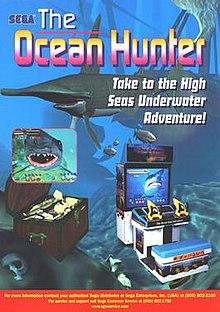| The Ocean Hunter | |
|---|---|
 Arcade poster | |
| Developer(s) | Sega |
| Publisher(s) | Sega |
| Director(s) | Shinichiro Okumoto |
| Composer(s) | Masanori Takeuchi |
| Platform(s) | Arcade |
| Release |
|
| Genre(s) | Rail shooter |
| Mode(s) | Single-player, Multiplayer |
| Arcade system | Sega Model 3 |
The Ocean Hunter (オーシャンハンター) (also known as "The Ocean Hunter: The Seven Seas Adventure") is a 1998 shooting gallery game developed and published by Sega.[1] The Ocean Hunter runs on Sega Model 3 hardware. The cabinet features artistic renditions of the bosses of the game, some with faux Greek names: Οχτοπυσ (actual Greek would be Όκτώπους); Λεϖιατηαν (actual Greek would be Λευιαθάν) and Χψχλοπσ (actual Greek would be Κύκλωψ).
Plot
A new civilization is flourishing in the seas of an alternate Steampunk world, but giant ocean monsters are attacking shipping vessels, harbors, humans and native marine life with increasing frequency. Ordinary marine predators such as sharks have begun to follow in the sea monsters' wake to scavenge what they could from the destruction caused. Frightened for their lives, the people issue bounties on the monsters' heads. The underwater adventurers Torel (Player 1) and Chris (Player 2) head out to defeat the horrible creatures.
The Seven Seas in-game are listed as:
- Baroque Sea (Pacific Coast near intersection of South America and Central America)
- Luna Sea (Off the Horn of Africa & Arabian Peninsula)
- Tartarus Deep (Near New England/Eastern Canada)
- Texcoco Great Lake (Deep in the Amazon region)
- North Sea (near Iceland)
- West Ocean (South Atlantic Ocean)
- Panthalassa (Mediterranean Sea)
Gameplay
The Ocean Hunter is played by using two mounted turret-like guns on the arcade cabinet. The game is capable of being played with either one or two people simultaneously. The player takes the role of an underwater adventurer searching for the Seven Great Monsters of the Seven Seas, hoping to collect the bounties placed on their heads for attacks on shipping vessels, humans and native marine life. The player proceeds to go throughout the game in a set path, shooting at various hostile ocean life along the way. The game is played progressing through various levels, each with its own design and layout, often incorporating the idea of sunken ships, underwater temples or cities of civilizations long gone. Upon reaching the end of the level, a boss is encountered. Each boss is named after a famous mythological sea monster: Kraken, Leviathan, Charybdis, Ahuizotl, Karkinos and Midgardsorm, with the final boss taking on different forms named Dagon, Poseidon, and Rahab. There are also mini-bosses in the game, many of them also named after sea monsters or mythological creatures.
Reception
In Japan, Game Machine listed The Ocean Hunter on their November 15, 1998 issue as being the fifth most-successful dedicated arcade game of the year.[2]
See also
- Let's Go Jungle!: Lost on the Island of Spice
- Let's Go Island: Lost on the Island of Tropics
- Transformers: Human Alliance
- Deadstorm Pirates
- Panic Museum